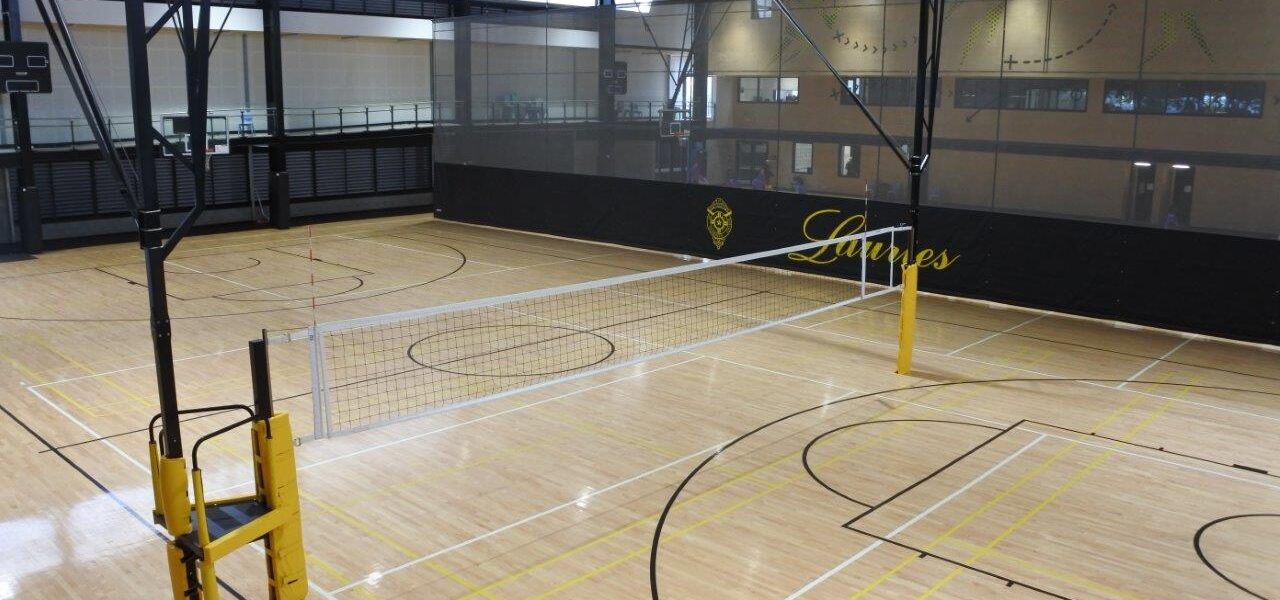By Kara Oughton
Volleyball is one of the most popular sports in the world, so it’s no surprise that there are endless equipment options and styles available on the market.
So, just how do you choose? Consider your facility size and layout, play level, multi-sport accessibility, and budget when making purchasing decisions.
Below we summarize each type of volleyball system and offer advantages and disadvantages of each type to help you decide between in the ground, in the air, or on the go!
Inground Systems
Inground or sleeved volleyball systems are the traditional style seen in most gymnasiums today. Holes are drilled into the flooring and sleeves are installed for the uprights, allowing the posts to be removed when needed.
These systems are the most cost-effective option for facilities and give consumers the largest selection of post materials, sizes, play levels, and configurations on the market. Facility managers like that the uprights can be transported to storage areas so that their courts can be used for multiple sports or activities.
In addition, some recreational inground systems are available with adjustable nets to accommodate tennis and badminton play, making them even more versatile.
One downside of inground systems is that the posts can be heavy and cumbersome to haul on and off the court, especially if storage areas are far away.
In addition, the process of drilling deep holes into gym flooring is expensive and time-consuming, and alternative floor anchors may be needed for older buildings, non-traditional flooring, or second story court areas.
Summary: Cost effective with a traditional style and tons of options, but requires sleeve installation and moving heavy uprights for multi-use courts
Ceiling-Suspended Systems
Ceiling-suspended volleyball systems have steadily gained popularity since their introduction into the market almost 15 years ago.
Similar to their basketball system counterparts, these systems consist of steel uprights that extend all the way up the ceiling for attachment, eliminating the need for floor sleeve installation.
Ceiling-hung systems can be raised up to the ceiling or lowered down to the court within minutes with the flip of a switch, saving facility personnel the hassle of setting the net and hauling heavy uprights on and off the court.
Additionally, there are many convenience upgrades available, such as electronic net height adjustment and operation via smartphone or tablet.
The main drawback to these types of systems is the high cost and a longer and more complex purchasing process.
In addition, facilities will need to determine if HVAC, lighting, or other hanging sports equipment could interfere with the systems, and certain building conditions may prevent ceiling attachment altogether.
Lastly, ceiling-hung systems will require an experienced contractor for installation, regular maintenance, and repairs/replacements, which may not fit into the tight budgets of smaller facilities or programs.
Summary: No need to drill into floors and easiest to operate, but most expensive to install, maintain, and repair
Portable Systems
Unlike lightweight, portable volleyball systems that have been around for many years for home or recreational use, competition portable systems are relatively new to the sports industry and they are already becoming a top choice for programs across the United States and worldwide.
Portable systems are constructed with two weighted bases that house the uprights, along with floor anchors designed to hold the bases in place.
The installation of these small anchors combined with the weighted base design eliminates the need for drilling deep holes for floor sleeves and makes installation a much quicker and easier process versus traditional systems.
Similar to other systems, portable units allow multi-use facilities to use their space for other scheduled activities during specific times, days, or seasons.
Even more convenient, the wheeled bases can be very easily pushed on and off the court so that employees are not burdened with carrying heavy posts to and from storage areas.
Lastly, fork lift slots at the bottom of the bases make these systems easier to transport for traveling volleyball tournaments and leagues.
Although portable systems are extremely convenient and easy to move, they are more expensive than traditional systems, and the base size and weight makes them bulky and hard to store if adequate space is not available.
Summary: Extremely convenient, especially for traveling leagues, but more expensive and bulkier for storage areas
Kara Oughton is the marketing manager for GARED, a sporting goods industry leader in innovative product design and precision equipment manufacturing, www.garedsports.com.











